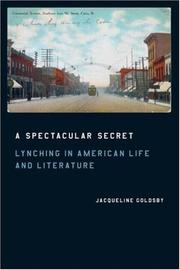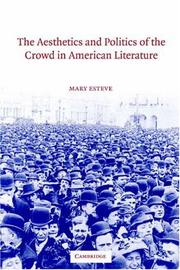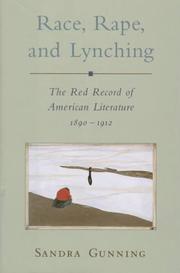| Listing 1 - 8 of 8 |
Sort by
|
Book
ISBN: 0805718141 0805783687 9780805783681 0805785728 9780805785722 Year: 1996 Publisher: New York: Twayne,
Abstract | Keywords | Export | Availability | Bookmark
 Loading...
Loading...Choose an application
- Reference Manager
- EndNote
- RefWorks (Direct export to RefWorks)
African Americans in literature --- Race relations in literature --- Miscegenation in literature --- Lynching in literature --- Time in literature --- Faulkner, William --- Mississippi
Book
ISBN: 9780252036491 9780252093524 0252093526 0252036492 1283582902 9781283582902 9786613895356 6613895350 0252078802 Year: 2011 Publisher: Urbana
Abstract | Keywords | Export | Availability | Bookmark
 Loading...
Loading...Choose an application
- Reference Manager
- EndNote
- RefWorks (Direct export to RefWorks)
'Living with Lynching' demonstrates that popular lynching plays were mechanisms through which African American communities survived actual and photographic mob violence. Often available in periodicals, lynching plays were read aloud or acted out by black church members, schoolchildren, and families. Koritha Mitchell shows that African Americans performed and read the scripts in community settings to certify to each other that lynching victims were not the isolated brutes that dominant discourses made them out to be. Instead, the play scripts often described victims as honourable heads of households being torn from model domestic units by white violence.
American drama --- African American authors --- History and criticism --- 20th century --- 19th century --- One-act plays [American ] --- Lynching in literature --- African Americans in literature --- Violence in literature --- Citizenship in literature --- Citizenship in literature. --- Violence in literature. --- African Americans in literature. --- Lynching in literature. --- One-act plays, American --- Afro-Americans in literature --- Negroes in literature --- American one-act plays --- History and criticism.
Book
ISBN: 1316792544 1107358531 1316789187 1107044138 1107620376 Year: 2016 Publisher: New York, NY : Cambridge University Press,
Abstract | Keywords | Export | Availability | Bookmark
 Loading...
Loading...Choose an application
- Reference Manager
- EndNote
- RefWorks (Direct export to RefWorks)
Beyond the Rope is an interdisciplinary study that draws on narrative theory and cultural studies methodologies to trace African Americans' changing attitudes and relationships to lynching over the twentieth century. Whereas African Americans are typically framed as victims of white lynch mob violence in both scholarly and public discourses, Karlos K. Hill reveals that in the late nineteenth and early twentieth centuries African Americans lynched other African Americans in response to alleged criminality, and that twentieth-century black writers envisaged African American lynch victims as exemplars of heroic manhood. By illuminating the submerged histories of black vigilantism and consolidating narratives of lynching in African American literature that framed black victims of white lynch mob violence as heroic, Hill argues that rather than being static and one dimensional, African American attitudes towards lynching and the lynched black evolved in response to changing social and political contexts.
Lynching --- African Americans --- Lynching in literature. --- Racism --- Afro-Americans --- Black Americans --- Colored people (United States) --- Negroes --- Africans --- Ethnology --- Blacks --- Homicide --- History --- Crimes against --- History. --- Black people --- Anti-lynching movements --- United States --- Race relations --- Crimes against.
Book
ISBN: 0813038707 0813043247 9780813038704 9780813043241 9780813035338 0813035333 081304152X 9780813041520 Year: 2011 Publisher: Gainesville, Fla. University Press of Florida
Abstract | Keywords | Export | Availability | Bookmark
 Loading...
Loading...Choose an application
- Reference Manager
- EndNote
- RefWorks (Direct export to RefWorks)
W. Jason Miller investigates the nearly three dozen poems written by Langston Hughes on the subject of lynching to explore its varying effects on survivors, victims, and accomplices as they resisted, accepted, and executed this brutal form of sadistic torture. In this work, Miller initiates an important dialogue between America's neglected history of lynching and some of the world's most significant poems. He begins with Hughes's teenage years during the Red Summer of 1919, moves on to the Scottsboro case beginning in 1931, then continues through WWII, the McCarthy era, the Red Scare, his interrogation before HUAC in the 1950s, and at last to the civil rights movement that took root toward the end of Hughes's life. Key poems, including "The Negro Speaks of Rivers," "Christ in Alabama," and "Dream Deferred," revisit the height of Hughes's overt resistance and anger as he ardently wrote to keep this topic in the forefront of American consciousness. Miller then traces the poet's use of allusion in his later works and ultimately examines how Hughes used strategies learned from photography to negotiate censorship in the 1950s. This volume represents a crucial and long-overdue contribution to our understanding of the art and politics of Langston Hughes---a man who never knew of an America where the very real threat of lynching was absent from the cultural landscape.
Lynching --- African Americans in literature. --- Lynching in literature. --- Afro-Americans in literature --- Negroes in literature --- Homicide --- History. --- Hughes, Langston, --- Hughes, James Langston, --- Khʹi︠u︡z, Lengston, --- Hiyūz, Lānkistūn, --- Khʹi︠u︡z, L. --- Huza, L., --- יוז, לענגסטאן, --- ヒューズラングストン, --- Political activity. --- Political and social views. --- Criticism and interpretation. --- Hugues, Langston --- Hughes, Langston --- Criticism and interpretation --- Political and social views --- Political activity --- Lynching in literature --- African Americans in literature --- United States --- History --- Anti-lynching movements

ISBN: 0226301389 0226301370 Year: 2006 Publisher: Chicago London University of Chicago Press
Abstract | Keywords | Export | Availability | Bookmark
 Loading...
Loading...Choose an application
- Reference Manager
- EndNote
- RefWorks (Direct export to RefWorks)
Lynchage dans la littérature --- Lynchen in de literatuur --- Lynching in literature --- American literature --- Lynching --- Homicide --- History and criticism --- Historiography --- History --- United States --- Race relations. --- Race question --- Race relations --- Wells, Ida Barnett --- Criticism and interpretation --- Crane, Stephen --- Johnson, James Weldon --- Brooks, Gwendolyn --- Anti-lynching movements
Book
ISBN: 9781617036651 Year: 2012 Publisher: Jackson : University Press of Mississippi,
Abstract | Keywords | Export | Availability | Bookmark
 Loading...
Loading...Choose an application
- Reference Manager
- EndNote
- RefWorks (Direct export to RefWorks)
Littérature américaine --- Lynchage --- Violence --- Auteurs noirs américains --- Thèmes, motifs --- Dans la littérature --- African Americans in popular culture --- American literature --- Lynching in literature --- Violence in literature --- Afro-Americans in popular culture --- Popular culture --- English literature --- Agrarians (Group of writers) --- African American authors&delete& --- History and criticism --- Thèmes, motifs. --- Dans la littérature. --- African American authors

ISBN: 1107133866 1280161337 0511120648 1139148206 0511064977 0511058640 0511305818 0511485492 0511073437 9780511064975 9780511073434 9780511120640 9780521814881 052181488X 9780511485497 9781280161339 9786610161331 661016133X 9780521035903 0521035902 9781107133860 9781139148207 9780511058646 9780511305818 Year: 2003 Publisher: Cambridge, UK New York Cambridge University Press
Abstract | Keywords | Export | Availability | Bookmark
 Loading...
Loading...Choose an application
- Reference Manager
- EndNote
- RefWorks (Direct export to RefWorks)
Mary Esteve provides a study of crowd representations in American literature from the antebellum era to the early twentieth century. As a central icon of political and cultural democracy, the crowd occupies a prominent place in the American literary and cultural landscape. Esteve examines a range of writing by Poe, Hawthorne, Lydia Maria Child, Du Bois, James, and Stephen Crane among others. These writers, she argues, distinguish between the aesthetics of immersion in a crowd and the mode of collectivity demanded of political-liberal subjects. In their representations of everyday crowds, ranging from streams of urban pedestrians to swarms of train travellers, from upper-class parties to lower-class revivalist meetings, such authors seize on the political problems facing a mass liberal democracy - problems such as the stipulations of citizenship, nation formation, mass immigration and the emergence of mass media. Esteve examines both the aesthetic and political meanings of such urban crowd scenes.
American literature --- Crowds in literature. --- Politics and literature --- Literature and society --- Collective behavior in literature. --- City and town life in literature. --- Immigrants in literature. --- Lynching in literature. --- Aesthetics, American. --- Mobs in literature. --- Race in literature. --- American aesthetics --- Literature --- Literature and politics --- History and criticism. --- Political aspects --- Arts and Humanities

ISBN: 0195099907 1280451645 0195356659 1602560749 0585328994 0199855102 Year: 1996 Volume: *3 Publisher: New York ; Oxford Oxford University Press
Abstract | Keywords | Export | Availability | Bookmark
 Loading...
Loading...Choose an application
- Reference Manager
- EndNote
- RefWorks (Direct export to RefWorks)
In the late nineteenth century, the stereotype of the black male as sexual beast functioned for white supremacists as an externalized symbol of social chaos against which all whites would unite for the purpose of national renewal. The emergence of this stereotype in American culture and literature during and after Reconstruction was related to the growth of white-on-black violence, as white lynch mobs acted in ""defense"" of white womanhood, the white family, and white nationalism. In Writing a Red Record Sandra Gunning investigates American literary encounters with the conditions, processes,
African Americans in literature
---
Afro-Americans in literature
---
Afro-Amerikanen in de literatuur
---
Afro-Américains dans la littérature
---
Amerikaanse zwarten in de literatuur
---
Black Americans in literature
---
Geweld in de literatuur
---
Lynchage dans la littérature
---
Lynchen in de literatuur
---
Lynching in literature
---
Negroes in literature
---
Noirs américains dans la littérature
---
Race dans la littérature
---
Race in literature
---
Rape in literature
---
Ras in de literatuur
---
Verkrachting in de literatuur
---
Viol dans la littérature
---
Violence dans la littérature
---
Violence in literature
---
Zwarte Amerikanen in de literatuur
---
American literature
---
Violence in literature.
---
Race in literature.
---
Littérature américaine
---
History and criticism.
---
Histoire et critique
---
-American literature
---
-Lynching in literature
---
#BIBC:ruil
| Listing 1 - 8 of 8 |
Sort by
|

 Search
Search Feedback
Feedback About UniCat
About UniCat  Help
Help News
News